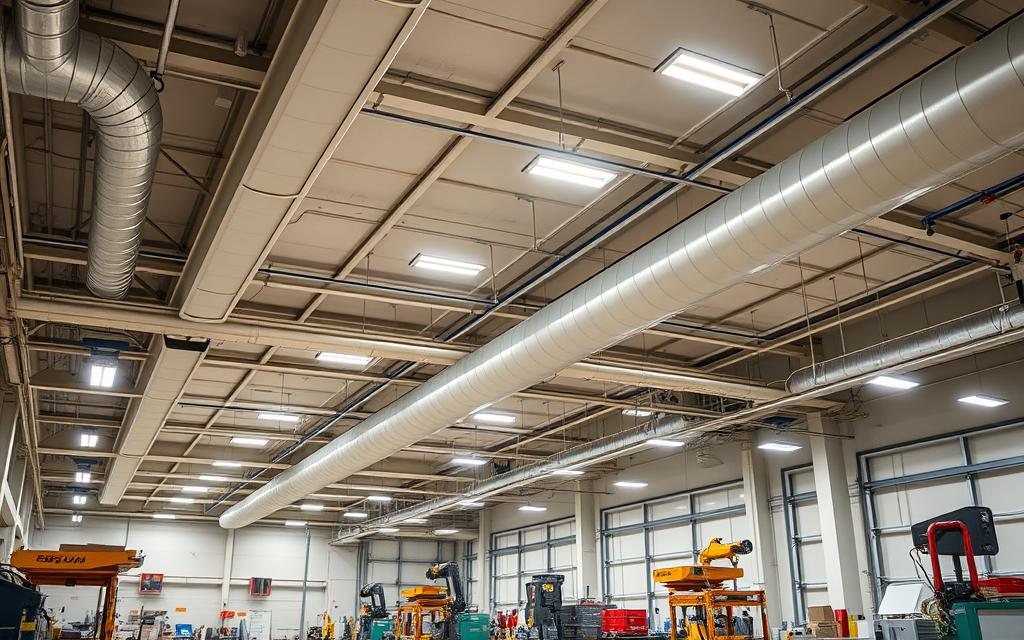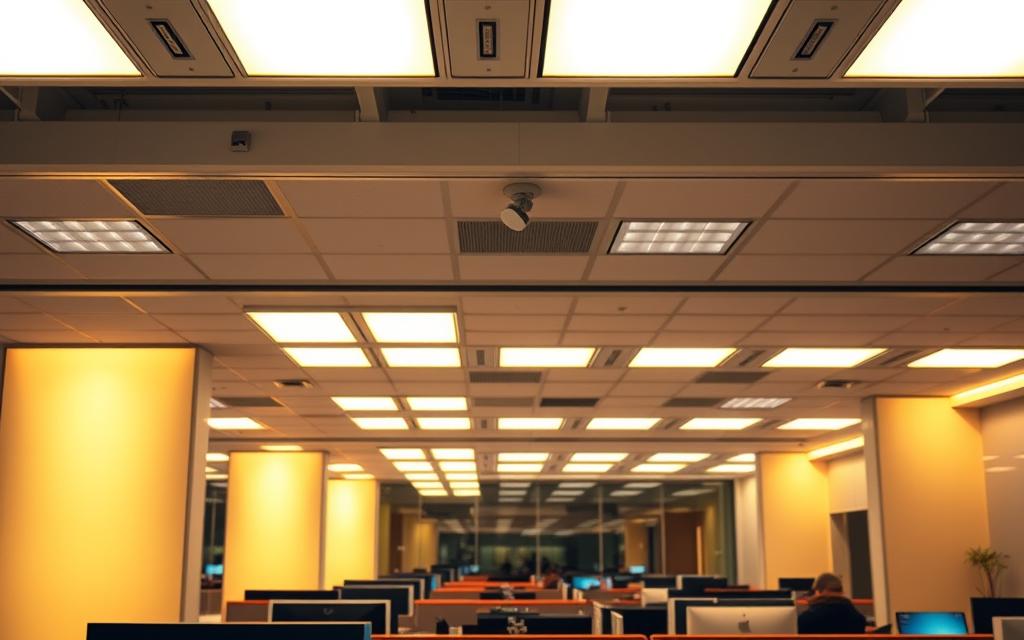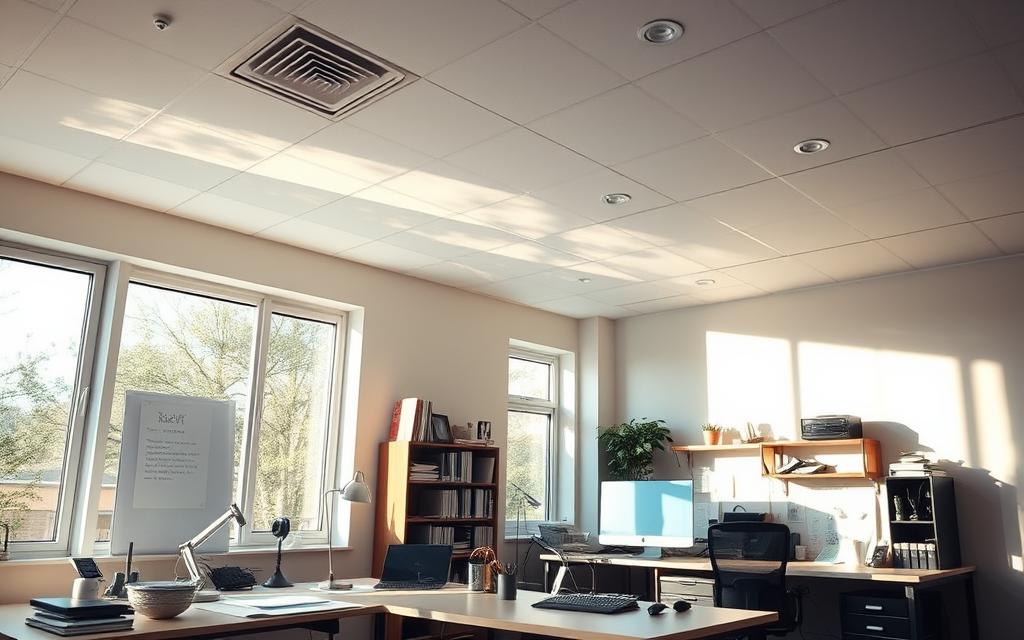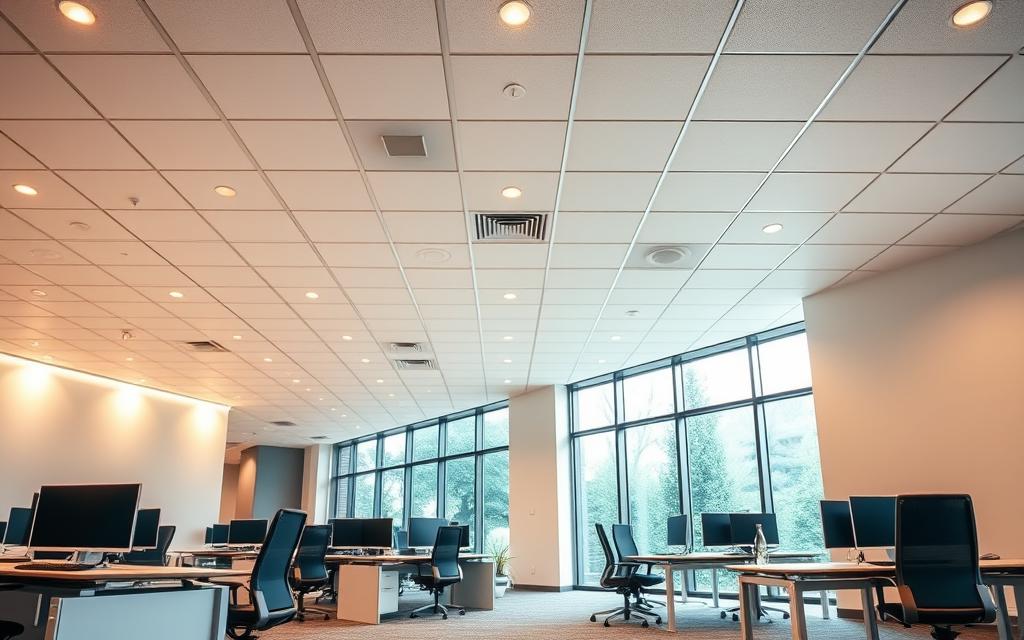Bright, well-designed workspaces aren’t just about aesthetics—they’re critical for safety and performance. Proper light reduces errors, prevents accidents, and keeps teams focused. Studies show employees in well-lit areas report fewer headaches and higher productivity compared to dim or unevenly illuminated spaces.
OSHA guidelines outline specific brightness levels for different tasks, ensuring hazards like machinery or tripping risks stay visible. Modern advancements, like energy-efficient LED fixtures, offer clearer illumination while cutting energy costs by up to 75%. These upgrades also reduce flicker and glare, addressing common complaints in older setups.
Beyond compliance, smart lighting systems adapt to natural daylight or task demands. For example, adjustable desk lamps in offices or motion-activated warehouse lights optimize both safety and efficiency. This flexibility minimizes eye strain, a major contributor to midday fatigue.
Up next, we’ll break down OSHA standards, compare bulb types, and share tips for tailoring light solutions to your workspace needs. Let’s shine a light on smarter strategies!
Understanding OSHA Lighting Requirements
Navigating OSHA’s rules begins with two critical measurements: foot-candles and lux levels. These units determine how much light reaches a surface, ensuring workers can spot hazards and perform tasks safely. For example, offices typically need 30-50 foot-candles, while construction zones require at least 5 foot-candles for basic visibility.

Key Terminology: Foot-Candles and Lux Levels
A foot-candle measures light intensity one foot from a source. Lux does the same but uses meters. One foot-candle equals about 10.76 lux. These metrics help employers set proper levels for different work areas. Too dim, and slips or errors rise. Too bright, and glare strains eyes.
Overview of OSHA Standards and Regulations
OSHA’s 1910 standard covers general workplaces, mandating minimums like 10 foot-candles in warehouses. Construction sites under OSHA 1926 need 5 foot-candles in walkways. Maritime settings (OSHA 1915) require 3 foot-candles for engine rooms. Meeting these rules isn’t just about compliance—consistent safety reduces accidents and keeps teams productive.
Regular audits using light meters ensure spaces stay within required ranges. Upgrading fixtures or adding task lamps can fine-tune brightness without overhauling systems. Clear standards mean fewer guesswork and more focused work environments.
Achieving Adequate Lighting in the Workplace
Optimal visibility isn’t a luxury—it’s a science-backed requirement for modern businesses. Specific environments demand tailored light amounts to balance visual clarity and comfort. For instance, offices thrive with 300-500 lux for reading documents, while labs handling intricate tasks need 750+ lux to reduce errors.
Defining Workspace Illumination Standards
Brightness needs vary by area and activity. Assembly lines require 1,000 lux to spot defects, whereas conference rooms function well at 200 lux. The right amount on surfaces like desks or machinery prevents squinting and improves reaction times. Adjustable fixtures help maintain these levels as daylight changes.
Safety and Output Go Hand in Hand
Proper illumination slashes eye strain by 50% in screen-heavy roles, per ergonomic studies. It also minimizes shadows in warehouses, helping workers spot spills or obstacles faster. Uniform light distribution across areas cuts headaches and keeps focus sharp during 3-hour tasks. For example, retail stores using 750 lux on displays see 18% fewer customer accidents.
Key Considerations for Optimal Illumination
Getting light right means balancing factors like sunlight, bulb color, and fixture angles. Natural light boosts mood but causes glare on screens. Cool-toned LEDs sharpen focus in labs, while warmer hues relax break rooms. OSHA reports 23% of office headaches stem from poor fixture placement.

Assessing Illumination Levels for Various Work Areas
Start by mapping where tasks happen. Assembly stations need 1,000+ lux for precision, but storage zones thrive at 300 lux. Use a light meter monthly—OSHA found 40% of warehouses fail annual checks. Position light fixtures 8-10 feet apart to avoid shadows. Dimmer switches help adjust for cloudy days.
Strategies to Reduce Glare and Eye Strain
Matte finishes on desks cut screen reflections by 60%. Install baffles or diffusers on overhead LEDs to soften beams. For computer work, 5000K color temps match daylight best. Task lamps with adjustable necks let workers control their light without disrupting others. Rotate bulbs every 2 years—dimming lowers quality work output.
Choose the right type for each space: pendant lights over tables, recessed in hallways. Anti-glare coatings on fixtures slash squinting during 3-hour shifts. Remember, consistent brightness isn’t just safer—it keeps teams 19% more alert.
Selecting the Right Light Fixtures and LED Solutions
Choosing fixtures isn’t just about brightness—it’s about meeting safety benchmarks while boosting efficiency. OSHA mandates specific protective measures to shield workers from electrical hazards or broken components. For example, fixtures in industrial zones need shatterproof shields and corrosion-resistant plates to handle impacts or moisture.
Fixture Requirements and Protective Standards
Proper mounting height matters. OSHA requires fixtures to be secured at least 7 feet above floors in high-traffic areas to prevent collisions. Enclosed designs with durable lenses reduce risks from exposed wiring or debris. Facilities using forklifts often install recessed lighting to maintain clear line sight along aisles.

Benefits and Efficiency of Modern LED Technology
LEDs outperform traditional bulbs in nearly every way. They use 60% less energy than fluorescents and last 25x longer, slashing replacement costs. Unlike older options, LEDs distribute bright light evenly, eliminating dark spots that strain eyes during 8-hour shifts. A factory upgrading to LEDs saw a 22% drop in error rates due to better visibility.
These fixtures also adapt to smart controls. Motion sensors in storage areas cut energy waste, while dimmable LEDs adjust levels based on daylight. For tailored guidance, explore our professional office lighting solutions designed to exceed OSHA standards.
Designing Effective Lighting Layouts for Different Workspaces
Tailoring illumination to different environments boosts both safety and efficiency. Each space has unique demands—from collaborative offices to fast-paced warehouses. Smart layouts prioritize employee comfort while delivering precise lux levels for tasks.

Office Lighting Best Practices
Position LED panels parallel to desks to minimize shadows. Pair overhead fixtures with adjustable task lamps for detail-oriented work. Use blinds to control window glare—angle computer screens away from direct light sources. For open-plan areas, aim for 500 lux measured with a digital meter.
Explore modular office designs that combine ambient and task lighting. This reduces eye strain during 4-hour focus sessions.
Industrial, Warehouse, and Retail Considerations
High bay LEDs work best for ceilings over 20 feet—space them 15 feet apart for uniform brightness. In retail, diffused lighting highlights products without harsh contrast. Warehouses benefit from motion-activated zones to maintain 300 lux in storage aisles.
Regularly test illumination with a handheld meter to spot dim areas. Proper layouts prevent accidents—like this ergonomic approach for high-traffic zones. Balance brightness between adjacent spaces to help eyes adjust smoothly.
Monitoring, Maintenance, and Compliance Practices
Consistent light quality isn’t a set-and-forget feature—it demands ongoing attention. Regular checks ensure fixtures meet OSHA standards while addressing wear-and-tear risks like flickering bulbs or cracked covers. This proactive approach keeps working zones safe and prevents costly downtime.

Regular Inspections and Light Meter Usage
Schedule monthly walk-throughs with a digital light meter to verify brightness levels. For example, compare readings near windows versus interior areas—adjust blinds or fixtures if variations exceed 20%. Document results in a shared log to track trends and spot dimming zones early.
Replace aging bulbs before they fail. OSHA reports 34% of violations stem from ignored maintenance. Keep spare parts on hand for quick fixes, especially along high-traffic lines where outages pose tripping hazards.
Keeping Up with OSHA and Regulatory Updates
Subscribe to OSHA email alerts for changes in light requirements. When standards shift—like updated lux levels for warehouses—plan upgrades within 90 days. Train teams to report issues like exposed wiring or misaligned blinds immediately.
Annual third-party audits add an extra quality check. They often catch overlooked gaps, such as shadows near storage racks or glare on computer screens. Pair these with staff surveys to gauge comfort and adjust layouts proactively.
Financial and Productivity Benefits of Proper Illumination
Smart illumination upgrades do more than brighten rooms—they fuel bottom-line growth. Companies switching to LED systems report 40% lower energy bills within 18 months. A Michigan office saved $12,000 annually by pairing motion sensors with daylight-responsive bulbs.

Workers in well-lit spaces complete tasks 27% faster, per Cornell studies. Reduced eye strain means fewer breaks during the day—teams handling computer tasks make 43% fewer errors under balanced light. One accounting firm saw productivity jump 19% after addressing screen glare issues.
- Energy-efficient LEDs cut utility costs by 50-75% vs traditional bulbs
- Proper illumination reduces accident-related insurance claims by 31% (OSHA data)
- Employees report 34% fewer headaches in offices with adjustable task lighting
Warehouses using smart fixtures saw ROI in 2.3 years through fewer product damages. The right light solutions create spaces where both spreadsheets and assembly lines thrive. When problems like shadows or flicker disappear, workers stay focused longer without midday slumps.
Investing in quality systems pays dividends: For every $1 spent upgrading office illumination, businesses gain $3 in productivity boosts. That’s bright thinking with clear returns.
Conclusion
Proper illumination transforms workspaces into safer, more productive environments. Following OSHA guidelines ensures hazards stay visible while reducing errors and fatigue. Regular checks catch dim zones or flickering fixtures before they impact sight or safety.
Strategic designs—like layered LED systems—boost output by 27% while cutting energy costs. Maintenance routines prevent accidents and keep teams focused during long shifts. Upgrading to modern tech pays off: facilities using smart sensors save up to 75% on utility bills over time.
Clear sight lines matter. Well-planned layouts minimize glare and shadows, helping workers spot tripping risks faster. Investing in quality fixtures isn’t just compliant—it builds trust and keeps productivity high.
Ready to shine? Audit your space today. Measure brightness levels, replace outdated bulbs, and watch costs drop as efficiency soars. Safer teams and smoother operations start with the flip of a switch.
